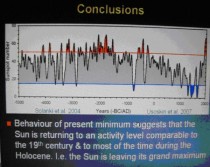By Dan Weil
New research from multiple scientists indicates the case for global warming isn’t as strong as some would have it.
The United Nations Intergovernmental Panel on Climate Change (IPCC) recently declared that “unequivocal” evidence shows human pollution is driving temperatures up.
It says the global temperature already has risen by 0.7 degree centigrade thanks to greenhouse gases. And it predicts another five to six degrees of extra heat by 2100, wreaking havoc on living things worldwide.
But many are now challenging that claim.
“The temperature records cannot be relied on as indicators of global change,” John Christy, professor of atmospheric science at the University of Alabama, Huntsville, a former lead author for the IPCC, told The Sunday Times of London.
He and others say weather stations that have been used to amass temperature data over the past 150 years may not be accurate. The stations have been affected by urbanization, changes in land use and in many instances moves to different locations.
Christy’s research examines the impact of those factors on three different regions: east Africa, California and Alabama.
“The story is the same for each one,” he said. “The popular data sets show a lot of warming but the apparent temperature rise was actually caused by local factors affecting the weather stations, such as land development.”
Ross McKitrick, professor of economics at the University of Guelph, Canada, agrees.
“We concluded, with overwhelming statistical significance, that the IPCC’s climate data are contaminated with surface effects from industrialization and data quality problems. These add up to a large warming bias,” he told The Sunday Times.
A new report by Joseph D’Aleo, a meteorologist who co-founded the Weather Channel, and veteran meteorologist Anthony Watts makes much the same points.
“Instrumental temperature data for the pre-satellite era (1850-1980) have been so widely, systemically and uni-directionally tampered with that it cannot be credibly asserted there has been any significant global warming in the 20th century,” they write.
“All terrestrial surface-temperature data bases exhibit very serious problems that render them useless for determining accurate long-term temperature trends.” Read more here.
--------------------------
IPCC Corruption Included Ignoring Facts and Science
By Dr. Tim Ball, Canada Free Press
Phil Jones, disgraced and dismissed Director of the Climatic Research Unit (CRU), granted BBC reporter Roger Harrabin an interview. Why Harrabin? His reporting has shown bias on all the IPCC and CRU activities. Leaked emails showed the CRU gang used friends in the BBC and that apparently continues. Prevarication, evasion, half-truths continue in Phil Jones’answers. Despite this there are stunning admissions from Jones. “There is a tendency in the IPCC reports to leave out inconvenient findings, especially in the part(s) most likely to be read by policy makers.”
It’s a deliberate strategy not just a tendency and not only in the Summary for Policymakers (SPM). Many major factors that create weather and can trigger change are ignored in the Scientific Report and computer models. Icecap Note: Tim then goes on in some detail to discuss one, the sun. He then concludes:
Watch the Richter Scale as Politicians Jump Off the IPCC Wagon
Jones only concedes some points but they are enough from the high priest of the CRU and IPCC to completely destroy its credibility. What will the sycophants and exploiters like Gore and the Mainstream Media do now? What about politicians who based positions and policy on environment and energy on the IPCC? What about the massive scams of Cap And Trade? What about the extreme environmental groups who have bullied and preached from the moral high ground? What about the scientists who took vehement positions without understanding? It is a very sad day for science, the people and the world. Read full post here.
-------------------------
Dalton Minimum Repeat goes mainstream
By David Archibald
The AGU Fall meeting has a session entitled “Aspects and consequences of an unusually deep and long solar minimum”. Two hours of video of this session can be accessed here.
Two of the papers presented had interesting observations with implications for climate. First of all Solanki came to the conclusion that the Sun is leaving its fifty to sixty year long grand maximum of the second half of the 20th century. He had said previously that the Sun was more active in the second half of the 20th century than in the previous 8,000 years. This is his last slide:

Enlarged here.
To get his papers published, Solanki has had genuflect to global warming. Perhaps he won’t have to do that from now on.
McCracken gave a paper with its title as per this slide:

Enlarged here.
While he states that it is his opinion alone and not necessarily held by his co-authors, he comes to the conclusion that a repeat of the Dalton Minimum is the most likely thing to happen next:

Dalton Minimum Repeat goes mainstream. Enlarged here.
Solar Cycle 24 is now just over a year old and the next event on the solar calendar is the year of maximum, which the green corona brightness tells us will be in 2015.
A repeat of the Dalton Minimum will have consequences for the Earth’s climate. Just how cold will it have to get for the Thames to freeze over, as it last did in 1815? See PDF here.
----------------------
Stimulating Green Jobs For China
Investor’s Business Daily
When even Chuck Schumer is upset with the White House, you know something’s amiss. In this case, it’s news that efforts to boost wind power with taxpayer stimulus dollars are filling foreign coffers and creating foreign jobs.
According to the Investigative Reporting Workshop at American University, nearly $2 billion in money from the American Recovery and Investment Act has been spent on wind power. The goal was to further energy independence while creating American jobs. It has done neither.
Of the money spent, according to the report, nearly 80% has gone to foreign manufacturers of wind turbines.
“In all due respect, I remind (Energy Secretary Steven Chu) there is a four-letter word associated with the stimulus - J-O-B-S,” Sen. Schumer, D-N.Y., told ABC News, which interviewed him for a report done in coordination with the workshop’s investigation. “Very few jobs here, lots of jobs in China.”
The only good thing one can say is that at least China is a real place, as opposed to the phantom ZIP codes and congressional districts in which the administration has claimed to have created jobs.
But how does buying wind turbines made in China create energy independence or create jobs?
Last October, on the day the workshop first reported on this story, a consortium of U.S. and Chinese companies announced a deal to build a $1.5 billion wind farm in Texas, using imported Chinese turbines.
The project is expected to create some temporary construction jobs in America. Some 2,000 manufacturing jobs will be created in China. In a message posted on his Facebook page, Secretary Chu wrote that the point of the grant program was “ensuring America leads the world in creating jobs in manufacturing the parts that go into wind farms” and even export components to foreign wind farms. It hasn’t worked out that way.
Of the 1,807 turbines erected on 28 wind farms receiving grants, foreign-owned manufacturers built 1,219, according to the workshop report. The installation of these turbines may have created as many as 6,838 manufacturing jobs overseas.
When the American Wind Energy Association released its 2009 year-end report on Jan. 26, CEO Denise Bode acknowledged that despite billions in stimulus spending, there had actually been a net loss in manufacturing jobs. Bode told USA Today she estimates the manufacturing job loss at 1,500.
Last March, a cargo of steel towers was unloaded at the port of Vancouver, Wash. They were made in Vietnam for a Danish wind company and destined for a Portuguese wind farm in Indiana that got a stimulus grant. Posted 02/11/2010 05:50 PM ET
The towers arrived in Washington state after traveling 7,400 miles from Vietnam’s Barra VANUATU province, where they were constructed by CS Wind - Vietnam’s leading steel tower manufacturer.
We’re all for free trade, but stimulus money was supposed to create jobs in America. As for helping us achieve energy independence, wind has failed miserably.
After decades of subsidies, wind provides only 1% of our electricity compared with 49% for coal, 22% for natural gas, 19% for nuclear power and 7% for hydroelectric. Wind turbines generally operate at only 20% efficiency vs. 85% for coal, gas and nuclear plants.
The irony is we leave vast reserves of job-creating domestic oil, coal and natural gas locked up as we sacrifice our economy to the Gaia, the goddess of climate change, something China has wisely refused to do. Read story here.
Speaking of China:
Frozen Cattle Crisis In Harsh Mongolia Winter
Sky News
Up to 20 million farm animals may die in Mongolia before spring as the fiercest winter in living memory grips the country, International Aid Agencies are being warned. Half the entire country’s livestock could be wiped out, local experts told the Red Cross.
A Sky News team that travelled through remote regions in Central Mongolia found cattle, goats and sheep frozen to death across the plains, with some herds almost completely wiped out. Outside her traditional home in Central Mongolia, grandmother Hotont Suon weeps as she looks at the carcasses of her herd lying on their backs.

Their legs in the air, they are frozen to death. In the pens, sheep huddle together from the bitter cold. Two died while we watched. Dogs and goats gnaw from the carcasses of the dead animals strewn outside the traditional “gurs”, the herders’ circular tented homesteads.
“Our hay is all gone now. As our goats die we sell the hides and buy more fodder, but it only lasts a few days,” she said. It’s called the “Dzud” - a multiple disaster with a summer drought followed by one of the coldest winters on record. It has left millions of livestock dying from a combination of exhaustion and starvation - some herders report that their cattle perish at the rate of 50 a night.
Some families have even been reduced to sharing their small tented home with the surviving animals. Inside a gur, a three-month-old baby played with a black wet-faced calf. The baby’s mother, Otgon Jargal, broke down in tears. “We have no skills. Our lives depend on our livestock. How can I look after my child when all the animals have died?” she cried.
The Mongolian government has appealed for food, medicine and animal food to combat one of the country’s worst natural disasters. The poorer herding families are left with insufficient food supplies to last out the winter. Many have taken out high interest loans to pay for animal fodder which they can’t meet.
Fears are also growing for thousands of herders who live in remote mountain regions in soutwestern Mongolia. There has been no word from thousands of people cut off in their villages by the heaviest snow fall in decades, prompting Mongolian air force helicopters to launch search and rescue operations.
Read more here. See this shocking video here.




